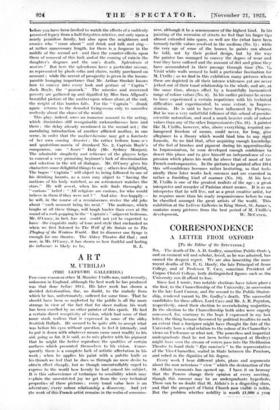ART
(THE LEFEVRE GALLERIES.)
Foie slime reason or other M. Maurice Utrillo was, until recently, unknown in England, although the best work he has produced was that done beforc 1914. His later work has shown a decided deterioration, due, no doubt, to the malady from which he has, unfortunately, suffered for some time. That he should have been so neglected by the public is all the more strange in view of the fact that for sheer realism his work has been excelled by no other painter of this epoch. Ile had a certain direct receptivity of vision, which had some of.that same stark realism that is expressed in some 'of- the older Scottish Ballads.. He seemed to be quite able to accept what was before his eyes without question, to feel it intensely, and to put it down with whatever means came most readily to his aid, going so far, it is said, as to mix plaster with his pigment that he might the better reproduce, the qualities of certain surfaces which presented themselves to his 'vision. Conse- quently there is a complete lack of artistic affectation in his work ; when he applies his -paint with a palette knife or his thumb we feel that he does so through no mere desire to obtain effect cheaply, but as though uncontrollably urged to express to the world how keenly he had sensed his subject. It is this subservience of technique to sensibility which may explain the unrestricted joy we get from the very technical properties of these pictures ; every tonal value here is' an adventure, every colour relationship a discovery. And. yet the work of this French artist remains in the reahnof sensuous- ness, although it be a sensuousness of the highest kind. In his painting of the recession of streets we feel that his finger tips almost extended into space, so well are the (what have been termed) tactile values -resolved in the medium (No. I) : while the very age of sonic of the houses, he paints can almost be told, not by their peikid design, but by the way the painter has managed to convey the degree of wear and tear they have suffered and the amount of dirt and grime they have accumulated in their passage throtigh time' (No. 7). Vivid white walls seemed to hold. a particular fascination for Utrillo ; so we find in this exhibition many pictures Where these are depicted in all their intense_ whiteness yet are never jerked out of their tonal relationship to the whole, and ate, at the same time, always offset :by a beautifully harmonized range of colour value's (No. 8). In hii earlier pictures he Seems to have experienced a certain impatience with hiS technical difficulties and exPerimentea, to some extent,' in Impres- sionism. He. is said to have been. influenced by Pissarro: But he was a -very unfaithful follower of this school of naturalism, and used a much heavier scale of Colour values than any of the other Impressionists (No. 21). A painter like M. Utrillo, however, who, above everything, requiredun- hampered freedom of means, could never, for long,,. give allegiance to a theory which woad bind him to- any rigid formula. So we find that, after acquiring, enough knowledge of the feel of brushes and pigment during his apprenticeship to Impressionism, he soon developed enough confidence to desert this phase and to give himself an independence of ex- pression which places his work far above that of most of his French contemporaries. In the pictures he painted after 191't this self-confidence becomes rather hesitating, so that tech- nically these dater works lack sureness and are executed in rather a fumbling kind of manner (No. 16). At his best M. Utrillo is one of the greatest realists of the age : a great interpreter and recorder of Parisian street scenes. It is. as an interpreter that he will live, not as a great creative artist, for he requires more thin his ready responsiveness before lie can be classified amongst the great artists of the world. This exhibithin at the Lefevre Galleries in King Street, St. James's, contains many pictures from the best period of M. Utrillo's














































 Previous page
Previous page